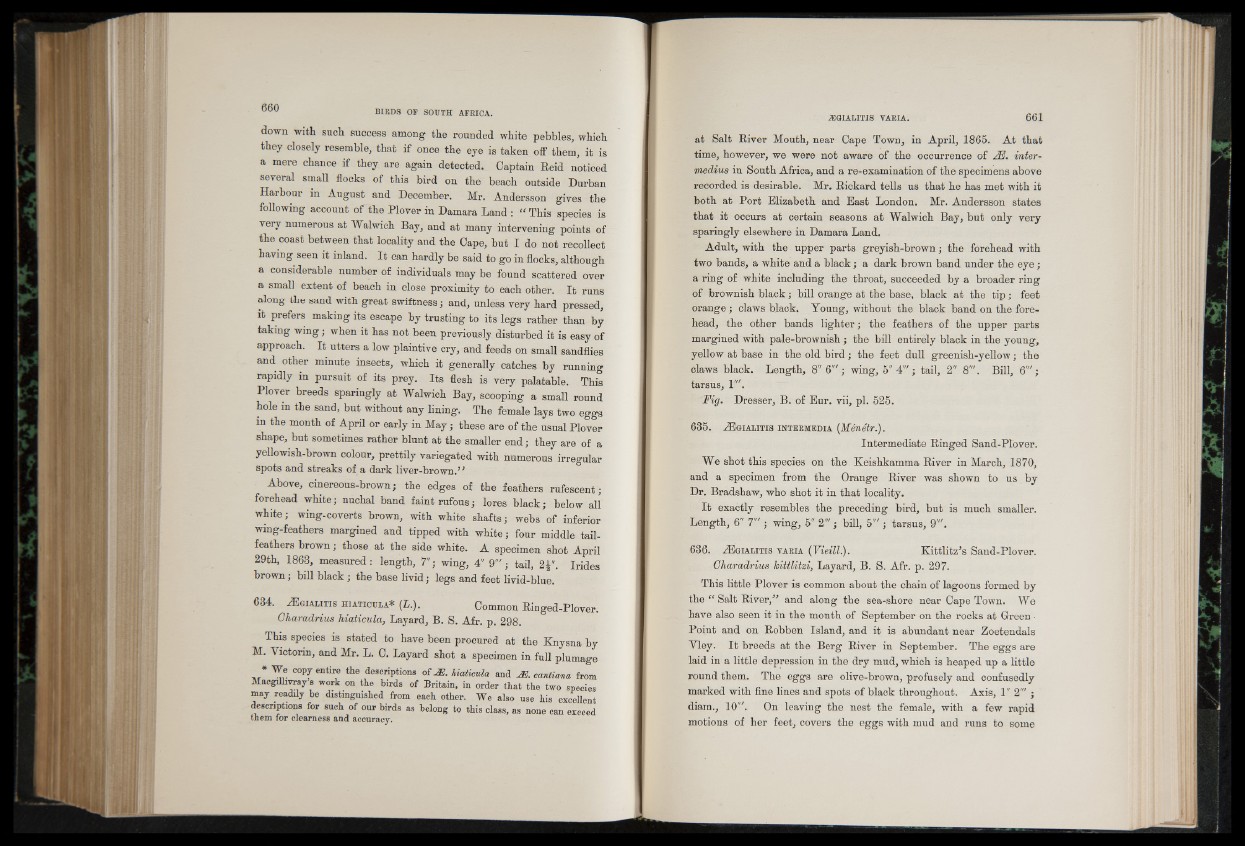
down with such success among the rounded white pebbles, which
they closely resemble, that if once the eye is taken off them, it is
a mere chance if they are again detected. Captain Reid noticed
several small flocks of this bird on the beach outside Durban
Harbour in August and December. Mr. Andersson gives the
following account of the Plover in Damara Land : “ This species is
very numerous at Walwich Bay, and at many intervening points of
the coast between that locality and the Cape, but I do not recollect
having seen it inland. It can hardly be said to go in flocks, although
a considerable number of individuals may be found scattered over
a small extent of beach in close proximity to each other. It r u n s
along the sand with great swiftness; and, unless very hard pressed,
it prefers making its escape by trusting to its legs rather than by
taking wing; when it has not been previously disturbed it is easy of
approach. It utters a low plaintive cry, and feeds on small sandflies
and other minute insects, which it generally catches by running
rapidly m pursuit of its prey. Its flesh is very palatable. This
Plover breeds sparingly at Walwich Bay, scooping a small round
hole in the sand, but without any lining. The female lays two eggs
in the month of April or early in May; these are of the usual Plover
shape, but sometimes rather blunt at the smaller end; they are of a
yellowish-brown colour, prettily variegated with numerous irregular
spots and streaks of a dark liver-brown.”
Above, cinereous-brown; the edges of the feathers rufescent;
forehead white; nuchal band faint rufous; lores black; below all
white; wing-coverts brown, with white shafts; webs of inferior
wing-feathers margined and tipped with white; four middle tail-
feathers brown; those at the side white. A specimen shot April
29th, 1863, measured: length, 7"; wing, 4" 9'"; tail, 2*". Irides
brown; bill black; the base livid; legs and feet livid-blue.
634. ^ E gia l it is hia t icu la * (L.). Common Ringed-Plover.
Charadrius hiaticula, Layard, B. S. Afr. p. 298.
This species is stated to have been procured at the Knysna by
M. Yictonn, and Mr. L. C. Layard shot a specimen in full plumage
* W e copy entire the descriptions o f hiaticula and JE. cantiana from
M acgillivra y s work on the birds o f B rita in , in order that the two species
may readily be distinguished from each other. W e also use his excellent
descriptions for such of our birds as belong to this class, as none can exceed
them for clearness and accuracy.
at Salt River Mouth, near Cape Town, in April, 1865. At that
time, however, we were not aware of the occurrence of JE. intermedins
in South Africa, and a re-examination of the specimens above
recorded is desirable. Mr. Rickard tells us that he has met with it
both at Port Elizabeth and East London. Mr. Andersson states
that it occurs at certain seasons at Walwich Bay, but only very
sparingly elsewhere in Damara Land.
Adult, with the upper parts greyish-brown; the forehead with
two bands, a white and a black; a dark brown band under the eye;
a ring of white including the throat, succeeded by a broader ring
of brownish black; bill orange at the base, black at the tip ; feet
orange ; claws black. Young, without the black band on the forehead,
the other bands lighter; the feathers of the upper parts
margined with pale-brownish; the bill entirely black in the young,
yellow at base in the old bird ; the feet dull greenish-yellow; the
claws black. Length, 8" 6'"; wing, 5" 4"'; tail, 2" 8"'. Bill, 6'";
tarsus, 1'".
Fig. Dresser, B. of Eur. vii, pi. 525.
635. .¿Eg ia l it is in t erm ed ia (Menetr.).
Intermediate Ringed Sand-PIover.
We shot this species on the Keishkamma River in March, 1870,
and a specimen from the Orange River was shown to us by
Dr. Bradshaw, who shot it in that locality.
It exactly resembles the preceding bird, but is much smaller.
Length, 6" 7" ; wing, 5" 2"'; bill, 5'" ; tarsus, 9'".
636. HSgia l it is varia (Vieill.). Kittlitz’s Sand-PIover.
Charadrius kittlitzi, Layard, B. S. Afr. p. 297.
This little Plover is common about the chain of lagoons formed by
the “ Salt River,” and along the sea-shore near Cape Town. We
have also seen it in the month of September on the rocks at Green •
Point and on Robben Island, and it is abundant near Zoetendals
Yley. It breeds at the Berg River in September. The eggs are
laid in a little depression in the dry mud, which is heaped up a little
round them. The eggs are olive-brown, profusely and confusedly
marked with fine lines and spots of black throughout. Axis, 1" 2"' ;
diam., 10'-'. On leaving the nest the female, with a few rapid
motions of her feet, covers the eggs with mud and runs to some